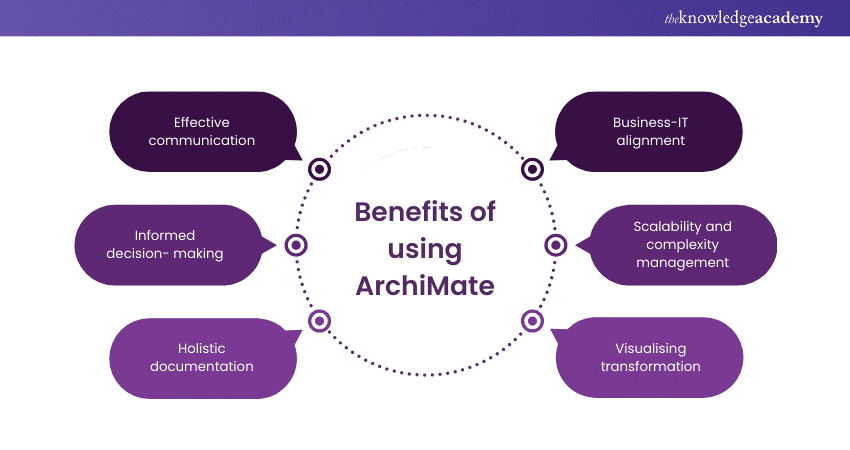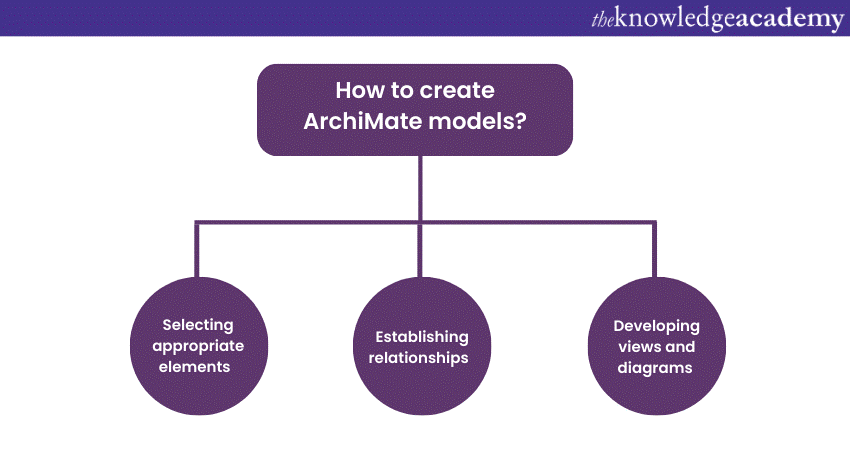We may not have the course you’re looking for. If you enquire or give us a call on +420 210012971 and speak to our training experts, we may still be able to help with your training requirements.
Training Outcomes Within Your Budget!
We ensure quality, budget-alignment, and timely delivery by our expert instructors.

ArchiMate Model Language serves as a blueprint for enterprise architecture, offering a standardised approach to describe, analyse, and visualise relationships within business domains. In 2004, the ArchiMate Model Language was introduced, revolutionising the way architects and stakeholders understand and implement changes in enterprise structures.
This comprehensive blog will delve into the ArchiMate Model Language, its framework, and its significance in aligning business strategies with information technology. Join us as we explore the intricacies of this powerful modelling language that has become integral to modern enterprise architecture.
Table of Contents
1) What is ArchiMate?
2) Benefits of using ArchiMate
3) Examples of ArchiMate Models
4) How to create ArchiMate Models?
5) Conclusion
What is ArchiMate?
Understanding ArchiMate means understanding how it is a visual modelling language specifically designed for enterprise architecture. ArchiMate provides an open and independent approach that, through its visual notation, is able to reveal, analyse, and communicate different kinds of systems and structural organisation inside an enterprise. ArchiMate has three layers: Business, Application, and Technology, which represent levels considered to be completely different aspects of the organisation’s architecture.
It uses a set of symbols and relationships to represent elements like business processes, applications, data, and infrastructure in a way that clearly and unambiguously describes that business enterprise to all involved.
ArchiMate will assure the architect that they are aligning business goals with IT strategies, determining where to make the needed adjustments within an enterprise, and, finally, ensuring they can make a wise decision about technology investment.
ArchiMate also guarantees broader interoperability with other architecture frameworks and tools, which will improve collaboration across a wide range of domains. This understanding of ArchiMate, in general, should give an architect the ability to develop a holistic and cohesive architectural model that can be used to drive organisational transformation, among other uses identified earlier.
Benefits of using ArchiMate
Adopting this language yields several benefits that significantly enhance the process of system design and enterprise architecture. This section explores these advantages in depth:

Effective communication
ArchiMate uses a common visual vocabulary that goes beyond the limitation of a text to model the different aspects of the enterprise. In simpler terms, such a common language could allow stakeholders with different backgrounds and expertise, like business analysts, software developers, and IT managers, to actually refer to one another while exchanging information. Clear and uniform representations of complex concepts, relations, and dependencies that may be misinterpreted by the case with dependency notation or that which encourages meaningful discussions
Informed decision-making
ArchiMate's visual representations empower stakeholders to make well-informed decisions by offering a tangible preview of potential changes or implementations. Architects can model different scenarios and assess the implications before committing resources, resulting in optimised choices and reduced risks.
Holistic documentation
This model serves as comprehensive documentation that encapsulates the intricacies of a system or enterprise. These models capture the structural elements and the dynamic behaviours, relationships, and dependencies. As a result, they become invaluable assets for future reference, knowledge transfer, and maintaining a clear record of architectural evolution.
Business-IT alignment
One of the key advantages presented by ArchiMate is that it spans the gap between business goals and IT implementation. ArchiMate spans the gap and allows stakeholders to line up strategic objectives regarding the technology solution being provided by offering a full view of enterprise architecture. Such an alignment brings about improved collaboration, ensures the ability to define changeable architectures easily, and ensures the technology decisions comply with business objectives.
Scalability and complexity management
ArchiMate's standardised framework and hierarchical structure enable architects to model and manage complex systems easily. It allows for decomposing large architectures into manageable components, making it simpler to analyse, optimise, and adapt as the system evolves.
Visualising transformation
ArchiMate excels in illustrating architectural transformations, making it an ideal tool for change management and modernisation initiatives. Architects can map the current state, design the desired future state, and visually depict the transition steps, helping stakeholders grasp the transformation journey.
Elevate your career with our ArchiMate® 3 Training – sign up today!
Examples of ArchiMate Models
Concrete examples display the real-world application of this language, illustrating how it captures the essence of complex architectures and fosters stakeholder understanding.
Business layer example
Assume that there is a retail business organisation that wants to adapt its supply chain management. A business layer model must exist, explaining different constituents like the actors (customers, suppliers), the business processes (order processing, inventory management), and the relationship between them.
A model would enable the visualisation of how a customer's order would finally result in the updating of corresponding procurement decisions. This would help stakeholders to visualise the bottlenecks, streamline the process, and, in so doing, improve customer satisfaction.
Application layer example
This model for an e-commerce platform's application layer could illustrate components like user interfaces, databases, and integration points in software development. This model would visualise how users interact with the interface, how data is stored and retrieved, and how different applications communicate. Architects and developers can use this model to optimise the user experience, identify potential performance bottlenecks, and ensure smooth integration between various software components.
Technology layer example
Consider a financial institution upgrading its IT infrastructure. The technology layer would display hardware components (servers, routers), software platforms (operating systems, databases), and connections between them. This model could visualise data flow and transactions across the network, identifying potential security vulnerabilities and ensuring compliance with industry standards.
How to create ArchiMate Models?
It requires a structured approach that involves selecting the correct elements, establishing meaningful relationships, and developing clear views and diagrams. We will show how to create models that accurately depict complex architectures:

Selecting appropriate elements
Begin by defining the scope and purpose. Identify the key aspects you want to represent, such as business processes, application components, or technology infrastructure. Then, choose the appropriate ArchiMate elements that best capture these aspects. For instance, in a business process model, you might select elements like "Business Process," "Actor," and "Role."
Begin your journey into enterprise architecture with our ArchiMate® 3 Level 1 Training.
Establishing relationships
The heart of this model lies in the relationships between elements. Define how different parts interact, depend on, or influence one another. Establish relationships that accurately depict the flow of activities, information, and behaviours within the architecture. Use ArchiMate's structural, dynamic, and dependency relationships to display these connections. For instance, you might create a structural relationship between a "Business Process" and an "Application Component" to depict how the process interacts with the software.
Developing views and diagrams
ArchiMate offers various viewpoints to capture different facets of architecture. Choose the appropriate views based on your audience and objectives. Develop diagrams focusing on specific layers (business, application, technology) or aspects (process flow, data flow). Use these diagrams to provide clear visualisations that highlight relevant elements and relationships. Label elements and relationships with concise descriptions to ensure clarity.
Utilise colours, shapes, and annotations to enhance the readability of your diagrams. Group related elements and emphasise critical paths to guide the viewer's attention. Consider creating multiple charts to represent different perspectives and levels of detail, ensuring that each diagram contributes to the overall understanding of the architecture.
Elevate your architecture skills with our comprehensive ArchiMate® Trainings and unlock new opportunities in enterprise architecture.
Conclusion
In conclusion, the ArchiMate Modelling language empowers architects and stakeholders to effectively communicate, design, and align complex systems. Its standardised visual representations bridge gaps, inform decisions, and drive successful implementations, making ArchiMate an indispensable tool in modern architecture and enterprise management.
Frequently Asked Questions

Industries such as banking, insurance, telecommunications, healthcare, and government sectors actively seek professionals proficient in ArchiMate Model Language. These professionals streamline operations, enhance IT systems, facilitate digital transformation, and align business strategies with technology initiatives.

Mastering ArchiMate can contribute to career advancement by enabling professionals to effectively design, communicate, and implement enterprise architecture solutions. This expertise enhances job performance, increases opportunities for leadership roles, and opens doors to higher-paying positions in diverse industries and sectors.

The Knowledge Academy takes global learning to new heights, offering over 30,000 online courses across 490+ locations in 220 countries. This expansive reach ensures accessibility and convenience for learners worldwide.
Alongside our diverse Online Course Catalogue, encompassing 17 major categories, we go the extra mile by providing a plethora of free educational Online Resources like News updates, Blogs, videos, webinars, and interview questions. Tailoring learning experiences further, professionals can maximise value with customisable Course Bundles of TKA.

The Knowledge Academy’s Knowledge Pass, a prepaid voucher, adds another layer of flexibility, allowing course bookings over a 12-month period. Join us on a journey where education knows no bounds.

The Knowledge Academy offers various ArchiMate® Trainings, including the ArchiMate® 3 Training- Level 1 and Level 2. These courses cater to different skill levels, providing comprehensive insights into ArchiMate Viewpoints.
Our Business Improvement Blogs cover a range of topics related to ArchiMate, offering valuable resources, best practices, and industry insights. Whether you are a beginner or looking to advance your ArchiMate skills, The Knowledge Academy's diverse courses and informative blogs have got you covered.
Upcoming Business Improvement Resources Batches & Dates
Date
 ArchiMate® 3 Training Course
ArchiMate® 3 Training Course
Thu 2nd Jan 2025
Thu 3rd Apr 2025
Thu 31st Jul 2025
Thu 6th Nov 2025







 Top Rated Course
Top Rated Course



 If you wish to make any changes to your course, please
If you wish to make any changes to your course, please


